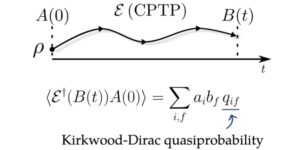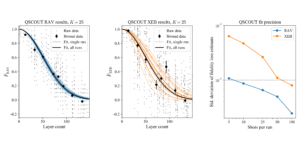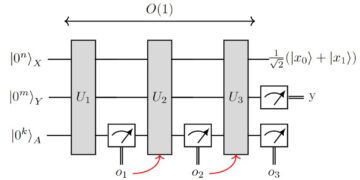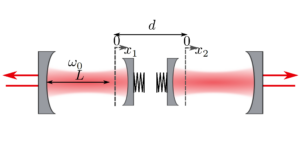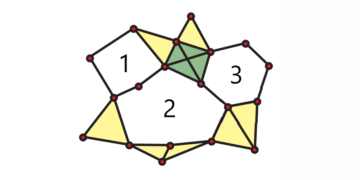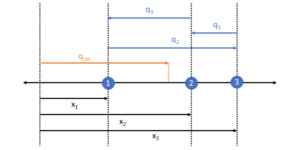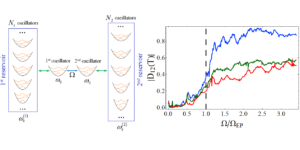1Physics Department, University of Massachusetts Boston, 02125, USA
2Dipartimento di Fisica `Ettore Pancini’, Università degli Studi di Napoli Federico II, Via Cintia 80126, Napoli, Italy
3INFN, Sezione di Napoli, Italy
Find this paper interesting or want to discuss? Scite or leave a comment on SciRate.
Abstract
Entanglement is the defining characteristic of quantum mechanics. Bipartite entanglement is characterized by the von Neumann entropy. Entanglement is not just described by a number, however; it is also characterized by its level of complexity. The complexity of entanglement is at the root of the onset of quantum chaos, universal distribution of entanglement spectrum statistics, hardness of a disentangling algorithm and of the quantum machine learning of an unknown random circuit, and universal temporal entanglement fluctuations. In this paper, we numerically show how a crossover from a simple pattern of entanglement to a universal, complex pattern can be driven by doping a random Clifford circuit with $T$ gates. This work shows that quantum complexity and complex entanglement stem from the conjunction of entanglement and non-stabilizer resources, also known as magic.
Featured image: Color map representation of a 16-qubit state after $10N^2$ random Clifford gates, then $n_T$ random $T$ gates $($Top row: $n_T{=}5$. Bottom row: $n_T{=}20)$, then another $10N^2$ random Clifford gates are applied, starting with the initial state $left|psi_0right>{=}left|0right>^{otimes N}$. The image is arranged by partitioning the state into two equal subsystems and expanding one along each axis. A pixel at some position $(x, y)$ is mapped from the magnitude of the amplitude for the computational basis state $left|sigma_{xy}right>{=}left|sigma_xright>{otimes}left|sigma_yright>$ $($for example, the pixel at $(0, 0)$ corresponds to the state $left|sigma_{00}right>{=}left|0right>^{otimes N/2}{otimes}left|0right>^{otimes N/2})$. The action of a $T$ gate, being a phase gate, does not change the color map representation at all. However, after being spread around by the second Clifford circuit, the color map representation becomes more mixed for the circuit with the larger number of inserted $T$ gates, showing the interplay between the non-Clifford resources and the operator spreading through Clifford-driven entanglement in the onset of quantum chaos.
► BibTeX data
► References
[1] J. P. Eckmann and D. Ruelle, Ergodic theory of chaos and strange attractors, Rev. Mod. Phys. 57, 617 (1985), 10.1103/RevModPhys.57.617.
https://doi.org/10.1103/RevModPhys.57.617
[2] D. Rickles, P. Hawe and A. Shiell, A simple guide to chaos and complexity, Journal of Epidemiology & Community Health 61(11), 933 (2007), 10.1136/jech.2006.054254.
https://doi.org/10.1136/jech.2006.054254
[3] G. Boeing, Visual analysis of nonlinear dynamical systems: Chaos, fractals, self-similarity and the limits of prediction, Systems 4(4) (2016), 10.3390/systems4040037.
https://doi.org/10.3390/systems4040037
[4] S. H. Strogatz, Nonlinear Dynamics and Chaos: With Applications to Physics, Biology, Chemistry and Engineering, Westview Press, 10.1201/9780429492563 (2015).
https://doi.org/10.1201/9780429492563
[5] F. Haake, S. Gnutzmann and M. Kuś, Quantum Signatures of Chaos, Springer International Publishing, 10.1007/978-3-319-97580-1 (2018).
https://doi.org/10.1007/978-3-319-97580-1
[6] J. S. Cotler, D. Ding and G. R. Penington, Out-of-time-order operators and the butterfly effect, Annals of Physics 396, 318 (2018), 10.1016/j.aop.2018.07.020.
https://doi.org/10.1016/j.aop.2018.07.020
[7] A. Bhattacharyya, W. Chemissany et al., Towards the web of quantum chaos diagnostics, The European Physical Journal C 82(1) (2022), 10.1140/epjc/s10052-022-10035-3.
https://doi.org/10.1140/epjc/s10052-022-10035-3
[8] S. Chaudhury, A. Smith et al., Quantum signatures of chaos in a kicked top, Nature 461(7265), 768 (2009), 10.1038/nature08396.
https://doi.org/10.1038/nature08396
[9] D. A. Roberts and B. Yoshida, Chaos and complexity by design, Journal of High Energy Physics 2017(4) (2017), 10.1007/jhep04(2017)121.
https://doi.org/10.1007/jhep04(2017)121
[10] D. A. Roberts and B. Swingle, Lieb-robinson bound and the butterfly effect in quantum field theories, Phys. Rev. Lett. 117, 091602 (2016), 10.1103/PhysRevLett.117.091602.
https://doi.org/10.1103/PhysRevLett.117.091602
[11] Y. Y. Atas, E. Bogomolny et al., Distribution of the ratio of consecutive level spacings in random matrix ensembles, Phys. Rev. Lett. 110, 084101 (2013), 10.1103/PhysRevLett.110.084101.
https://doi.org/10.1103/PhysRevLett.110.084101
[12] J. Cotler, N. Hunter-Jones et al., Chaos, complexity, and random matrices, Journal of High Energy Physics (Online) 2017(11) (2017), 10.1007/jhep11(2017)048.
https://doi.org/10.1007/jhep11(2017)048
[13] J. S. Cotler, G. Gur-Ari et al., Black holes and random matrices, Journal of High Energy Physics 2017(5), 118 (2017), 10.1007/JHEP05(2017)118.
https://doi.org/10.1007/JHEP05(2017)118
[14] H. Gharibyan, M. Hanada et al., Onset of random matrix behavior in scrambling systems, Journal of High Energy Physics 2018(7), 124 (2018), 10.1007/JHEP07(2018)124.
https://doi.org/10.1007/JHEP07(2018)124
[15] S. F. E. Oliviero, L. Leone et al., Random Matrix Theory of the Isospectral twirling, SciPost Phys. 10, 76 (2021), 10.21468/SciPostPhys.10.3.076.
https://doi.org/10.21468/SciPostPhys.10.3.076
[16] L. Leone, S. F. E. Oliviero and A. Hamma, Isospectral twirling and quantum chaos, Entropy 23(8) (2021), 10.3390/e23081073.
https://doi.org/10.3390/e23081073
[17] W.-J. Rao, Higher-order level spacings in random matrix theory based on wigner’s conjecture, Phys. Rev. B 102, 054202 (2020), 10.1103/PhysRevB.102.054202.
https://doi.org/10.1103/PhysRevB.102.054202
[18] X. Wang, S. Ghose et al., Entanglement as a signature of quantum chaos, Phys. Rev. E 70, 016217 (2004), 10.1103/PhysRevE.70.016217.
https://doi.org/10.1103/PhysRevE.70.016217
[19] X. Chen and A. W. W. Ludwig, Universal spectral correlations in the chaotic wave function and the development of quantum chaos, Phys. Rev. B 98, 064309 (2018), 10.1103/PhysRevB.98.064309.
https://doi.org/10.1103/PhysRevB.98.064309
[20] P. Hosur, X.-L. Qi et al., Chaos in quantum channels, Journal of High Energy Physics 2016, 4 (2016), 10.1007/JHEP02(2016)004.
https://doi.org/10.1007/JHEP02(2016)004
[21] Z.-W. Liu, S. Lloyd et al., Entanglement, quantum randomness, and complexity beyond scrambling, Journal of High Energy Physics 2018(7) (2018), 10.1007/jhep07(2018)041.
https://doi.org/10.1007/jhep07(2018)041
[22] M. Kumari and S. Ghose, Untangling entanglement and chaos, Phys. Rev. A 99, 042311 (2019), 10.1103/PhysRevA.99.042311.
https://doi.org/10.1103/PhysRevA.99.042311
[23] A. Hamma, S. Santra and P. Zanardi, Quantum entanglement in random physical states, Phys. Rev. Lett. 109, 040502 (2012), 10.1103/PhysRevLett.109.040502.
https://doi.org/10.1103/PhysRevLett.109.040502
[24] A. Hamma, S. Santra and P. Zanardi, Ensembles of physical states and random quantum circuits on graphs, Phys. Rev. A 86, 052324 (2012), 10.1103/PhysRevA.86.052324.
https://doi.org/10.1103/PhysRevA.86.052324
[25] R. Jozsa, Entanglement and quantum computation, 10.48550/ARXIV.QUANT-PH/9707034 (1997).
https://doi.org/10.48550/ARXIV.QUANT-PH/9707034
[26] J. Preskill, Quantum computing and the entanglement frontier, 10.48550/ARXIV.1203.5813 (2012).
https://doi.org/10.48550/ARXIV.1203.5813
[27] Y. Sekino and L. Susskind, Fast scramblers, Journal of High Energy Physics 2008(10), 065 (2008), 10.1088/1126-6708/2008/10/065.
https://doi.org/10.1088/1126-6708/2008/10/065
[28] P. Hayden and J. Preskill, Black holes as mirrors: quantum information in random subsystems, Journal of High Energy Physics 2007(09), 120 (2007), 10.1088/1126-6708/2007/09/120.
https://doi.org/10.1088/1126-6708/2007/09/120
[29] K. A. Landsman, C. Figgatt et al., Verified quantum information scrambling, Nature 567(7746), 61–65 (2019), 10.1038/s41586-019-0952-6.
https://doi.org/10.1038/s41586-019-0952-6
[30] B. Yoshida and A. Kitaev, Efficient decoding for the hayden-preskill protocol, 10.48550/ARXIV.1710.03363 (2017).
https://doi.org/10.48550/ARXIV.1710.03363
[31] D. Ding, P. Hayden and M. Walter, Conditional mutual information of bipartite unitaries and scrambling, Journal of High Energy Physics 2016(12), 145 (2016), 10.1007/JHEP12(2016)145.
https://doi.org/10.1007/JHEP12(2016)145
[32] B. Swingle, G. Bentsen et al., Measuring the scrambling of quantum information, Physical Review A 94, 040302 (2016), 10.1103/PhysRevA.94.040302.
https://doi.org/10.1103/PhysRevA.94.040302
[33] D. Gottesman, The heisenberg representation of quantum computers (1998), 10.48550/ARXIV.QUANT-PH/9807006.
https://doi.org/10.48550/ARXIV.QUANT-PH/9807006
[34] M. A. Nielsen and I. L. Chuang, Quantum information theory, p. 528–607, Cambridge University Press, 10.1017/CBO9780511976667.016 (2010).
https://doi.org/10.1017/CBO9780511976667.016
[35] A. W. Harrow and A. Montanaro, Quantum computational supremacy, Nature 549(7671), 203–209 (2017), 10.1038/nature23458.
https://doi.org/10.1038/nature23458
[36] R. P. Feynman, Simulating physics with computers, International Journal of Theoretical Physics 21(6), 467 (1982), 10.1007/BF02650179.
https://doi.org/10.1007/BF02650179
[37] L. Leone, S. F. E. Oliviero et al., Quantum Chaos is Quantum, Quantum 5, 453 (2021), 10.22331/q-2021-05-04-453.
https://doi.org/10.22331/q-2021-05-04-453
[38] S. F. Oliviero, L. Leone and A. Hamma, Transitions in entanglement complexity in random quantum circuits by measurements, Physics Letters A 418, 127721 (2021), 10.1016/j.physleta.2021.127721.
https://doi.org/10.1016/j.physleta.2021.127721
[39] S. Bravyi and D. Gosset, Improved classical simulation of quantum circuits dominated by Clifford gates, Physical Review Letters 116, 250501 (2016), 10.1103/PhysRevLett.116.250501.
https://doi.org/10.1103/PhysRevLett.116.250501
[40] J. Haferkamp, F. Montealegre-Mora et al., Quantum homeopathy works: Efficient unitary designs with a system-size independent number of non-clifford gates, 10.48550/ARXIV.2002.09524 (2020).
https://doi.org/10.48550/ARXIV.2002.09524
[41] P. Boykin, T. Mor et al., A new universal and fault-tolerant quantum basis, Information Processing Letters 75(3), 101 (2000), 10.1016/S0020-0190(00)00084-3.
https://doi.org/10.1016/S0020-0190(00)00084-3
[42] D. Gottesman, An introduction to quantum error correction and fault-tolerant quantum computation, 10.48550/ARXIV.0904.2557 (2009).
https://doi.org/10.48550/ARXIV.0904.2557
[43] N. J. Ross and P. Selinger, Optimal ancilla-free clifford+t approximation of z-rotations, Quantum Info. Comput. 16(11–12), 901–953 (2016), 10.26421/QIC16.11-12-1.
https://doi.org/10.26421/QIC16.11-12-1
[44] D. Litinski, A game of surface codes: Large-scale quantum computing with lattice surgery, Quantum 3, 128 (2019), 10.22331/q-2019-03-05-128.
https://doi.org/10.22331/q-2019-03-05-128
[45] T. Bækkegaard, L. B. Kristensen et al., Realization of efficient quantum gates with a superconducting qubit-qutrit circuit, Scientific Reports 9(1) (2019), 10.1038/s41598-019-49657-1.
https://doi.org/10.1038/s41598-019-49657-1
[46] Q. Wang, M. Li et al., Resource-optimized fermionic local-hamiltonian simulation on a quantum computer for quantum chemistry, Quantum 5, 509 (2021), 10.22331/q-2021-07-26-509.
https://doi.org/10.22331/q-2021-07-26-509
[47] V. Gheorghiu, M. Mosca and P. Mukhopadhyay, T-count and t-depth of any multi-qubit unitary, 10.48550/ARXIV.2110.10292 (2021).
https://doi.org/10.48550/ARXIV.2110.10292
[48] C. Chamon, A. Hamma and E. R. Mucciolo, Emergent irreversibility and entanglement spectrum statistics, Physical Review Letters 112, 240501 (2014), 10.1103/PhysRevLett.112.240501.
https://doi.org/10.1103/PhysRevLett.112.240501
[49] D. Shaffer, C. Chamon et al., Irreversibility and entanglement spectrum statistics in quantum circuits, Journal of Statistical Mechanics: Theory and Experiment 2014(12), P12007 (2014), 10.1088/1742-5468/2014/12/p12007.
https://doi.org/10.1088/1742-5468/2014/12/p12007
[50] S. Zhou, Z. Yang et al., Single T gate in a Clifford circuit drives transition to universal entanglement spectrum statistics, SciPost Phys. 9, 87 (2020), 10.21468/SciPostPhys.9.6.087.
https://doi.org/10.21468/SciPostPhys.9.6.087
[51] Z. Yang, A. Hamma et al., Entanglement complexity in quantum many-body dynamics, thermalization, and localization, Physical Review B 96, 020408 (2017), 10.1103/PhysRevB.96.020408.
https://doi.org/10.1103/PhysRevB.96.020408
[52] A. Nahum, J. Ruhman et al., Quantum entanglement growth under random unitary dynamics, Physical Review X 7(3) (2017), 10.1103/physrevx.7.031016.
https://doi.org/10.1103/physrevx.7.031016
[53] A. Nahum, S. Vijay and J. Haah, Operator spreading in random unitary circuits, Physical Review X 8, 021014 (2018), 10.1103/PhysRevX.8.021014.
https://doi.org/10.1103/PhysRevX.8.021014
[54] X. Mi, P. Roushan et al., Information scrambling in quantum circuits, Science 374(6574), 1479–1483 (2021), 10.1126/science.abg5029.
https://doi.org/10.1126/science.abg5029
[55] D. A. Roberts, D. Stanford and L. Susskind, Localized shocks, Journal of High Energy Physics 2015(3), 51 (2015), 10.1007/JHEP03(2015)051.
https://doi.org/10.1007/JHEP03(2015)051
[56] S. Moudgalya, T. Devakul et al., Operator spreading in quantum maps, Physical Review B 99(9) (2019), 10.1103/physrevb.99.094312.
https://doi.org/10.1103/physrevb.99.094312
[57] L. Amico, F. Baroni et al., Divergence of the entanglement range in low-dimensional quantum systems, Phys. Rev. A 74, 022322 (2006), 10.1103/PhysRevA.74.022322.
https://doi.org/10.1103/PhysRevA.74.022322
[58] N. Linden, S. Popescu et al., Quantum mechanical evolution towards thermal equilibrium, Physical Review E 79, 061103 (2009), 10.1103/PhysRevE.79.061103.
https://doi.org/10.1103/PhysRevE.79.061103
[59] J. R. McClean, S. Boixo et al., Barren plateaus in quantum neural network training landscapes, Nature Communications 9(1), 4812 (2018), 10.1038/s41467-018-07090-4.
https://doi.org/10.1038/s41467-018-07090-4
[60] Z. Holmes, A. Arrasmith et al., Barren plateaus preclude learning scramblers, Phys. Rev. Lett. 126, 190501 (2021), 10.1103/PhysRevLett.126.190501.
https://doi.org/10.1103/PhysRevLett.126.190501
[61] M. Cerezo, A. Sone et al., Cost function dependent barren plateaus in shallow parametrized quantum circuits, Nature Communications 12(1), 1791 (2021), 10.1038/s41467-021-21728-w.
https://doi.org/10.1038/s41467-021-21728-w
[62] R. J. Garcia, C. Zhao et al., Barren plateaus from learning scramblers with local cost functions, 10.48550/ARXIV.2205.06679 (2022).
https://doi.org/10.48550/ARXIV.2205.06679
[63] L. Leone, S. F. E. Oliviero and A. Hamma, Stabilizer Rényi Entropy, Phys. Rev. Lett. 128(5), 050402 (2022), 10.1103/PhysRevLett.128.050402.
https://doi.org/10.1103/PhysRevLett.128.050402
[64] E. T. Campbell, Catalysis and activation of magic states in fault-tolerant architectures, Physical Review A 83(3) (2011), 10.1103/physreva.83.032317.
https://doi.org/10.1103/physreva.83.032317
[65] K. Goto, T. Nosaka and M. Nozaki, Chaos by magic, 10.48550/ARXIV.2112.14593 (2021).
https://doi.org/10.48550/ARXIV.2112.14593
[66] A. W. Harrow, L. Kong et al., Separation of out-of-time-ordered correlation and entanglement, PRX Quantum 2, 020339 (2021), 10.1103/PRXQuantum.2.020339.
https://doi.org/10.1103/PRXQuantum.2.020339
[67] L. Leone, S. F. E. Oliviero et al., To learn a mocking-black hole, 10.48550/ARXIV.2206.06385 (2022).
https://doi.org/10.48550/ARXIV.2206.06385
Cited by
[1] Lorenzo Leone, Salvatore F. E. Oliviero, and Alioscia Hamma, “Magic hinders quantum certification”, arXiv:2204.02995.
[2] Tobias Haug and M. S. Kim, “Scalable measures of magic for quantum computers”, arXiv:2204.10061.
[3] Lorenzo Leone, Salvatore F. E. Oliviero, Stefano Piemontese, Sarah True, and Alioscia Hamma, “To Learn a Mocking-Black Hole”, arXiv:2206.06385.
The above citations are from SAO/NASA ADS (last updated successfully 2022-09-22 16:45:47). The list may be incomplete as not all publishers provide suitable and complete citation data.
Could not fetch Crossref cited-by data during last attempt 2022-09-22 16:45:45: Could not fetch cited-by data for 10.22331/q-2022-09-22-818 from Crossref. This is normal if the DOI was registered recently.
This Paper is published in Quantum under the Creative Commons Attribution 4.0 International (CC BY 4.0) license. Copyright remains with the original copyright holders such as the authors or their institutions.



